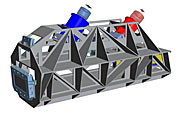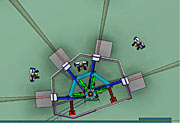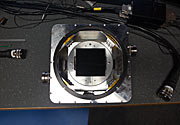Tiedote
ESO Awards Contracts for Cameras for New Planet Finder
7. elokuuta 2013
ESO has signed contracts with Winlight Systems (France) for the construction of two cameras for the powerful new exoplanet-finding instrument, ESPRESSO.
ESPRESSO (Echelle SPectrograph for Rocky Exoplanet and Stable Spectroscopic Observations) is an ultra-stable spectrograph that will be installed at ESO’s Paranal Observatory in Chile in 2016. It will be capable of combining light from all four Unit Telescopes of the Very Large Telescope (VLT) to create a virtual 16-metre aperture telescope [1]. ESPRESSO is being developed by a consortium consisting of ESO and seven further scientific institutes:
- Centro de Astrofísica da Universidade do Porto (Portugal)
- Faculdade de Ciências da Universidade de Lisboa, CAAUL & LOLS (Portugal)
- INAF–Osservatorio Astronomico di Trieste (Italy)
- INAF–Osservatorio Astronomico di Brera (Italy)
- Instituto de Astrofísica de Canarias (Spain)
- Physikalisches Institut der Universität Bern (Switzerland)
- Université de Genève (Switzerland).
ESPRESSO will build on the foundations laid by the hugely successful High Accuracy Radial velocity Planet Searcher (HARPS) instrument at the 3.6-metre telescope at ESO’s La Silla Observatory. ESPRESSO will benefit not only from the much larger combined light-collecting capacity of the four 8.2-metre VLT Unit Telescopes, but also from improvements in the stability and calibration accuracy that are now possible (for example, laser frequency comb technology).
ESPRESSO is expected to allow astronomers to detect Earth-like planets around nearby stars using the radial velocity method [2]. It will also have many other science applications, including the search for possible variations of the constants of nature at different times and in different directions through the study of the light from very distant quasars.
The new contract is for the provision of the two refractive cameras, one for the red and one for the blue parts of the spectrum. These are vital components of the instrument. Utilising highly non-spherical surfaces and novel design principles, they achieve excellent image quality over a large field with only three optical elements.
Notes
[1] ESPRESSO will be the first instrument that combines light from all four Unit Telescopes at an incoherent focus. The PIONIER instrument has already achieved the combination of four beams for the purposes of interferometry, where the beams are combined coherently (ann11021).
[2] A planet in orbit around a star introduces a small and regular variation in the velocity component as measured along the line of sight (known as the radial velocity) by a distant observer on Earth. This variation can be observed as a “wobble” in the spectrum of the star as the lines shift to and fro about their central position as a result of the Doppler effect. As the planet moves away from the observer the radial velocity change induces a shift of the star’s spectrum towards longer wavelengths (a redshift) and shorter wavelengths as it moves closer (a blueshift). These tiny shifts in the star’s spectrum (corresponding to velocities as low as 10 cm/s; about the speed of a tortoise) can be measured with a high-precision spectrograph such as ESPRESSO, and can be used to infer the presence of planets.
Yhteystiedot
Hans Dekker
ESPRESSO Instrumentation Engineer at ESO
Garching bei München, Germany
Tel: +49 89 3200 6268
Email: hdekker@eso.org
Francesco Pepe
ESPRESSO Prime Investigator
Observatoire Astronomique de l'Université de Genève
Tel +41 22 379 23 96
Email: Francesco.Pepe@unige.ch
Johannes Schimpelsberger
ESO, Contract Officer, Contracts and Procurement
Garching bei München, Germany
Tel: + 49 89 3200 6381
Email: jschimpe@eso.org
Richard Hook
ESO, Public Information Officer
Garching bei München, Germany
Tel: +49 89 3200 6655
Cell: +49 151 1537 3591
Email: rhook@eso.org
Tiedotteesta
| Tunnistus: | ann13065 |
Our use of Cookies
We use cookies that are essential for accessing our websites and using our services. We also use cookies to analyse, measure and improve our websites’ performance, to enable content sharing via social media and to display media content hosted on third-party platforms.
ESO Cookies Policy
The European Organisation for Astronomical Research in the Southern Hemisphere (ESO) is the pre-eminent intergovernmental science and technology organisation in astronomy. It carries out an ambitious programme focused on the design, construction and operation of powerful ground-based observing facilities for astronomy.
This Cookies Policy is intended to provide clarity by outlining the cookies used on the ESO public websites, their functions, the options you have for controlling them, and the ways you can contact us for additional details.
What are cookies?
Cookies are small pieces of data stored on your device by websites you visit. They serve various purposes, such as remembering login credentials and preferences and enhance your browsing experience.
Categories of cookies we use
Essential cookies (always active): These cookies are strictly necessary for the proper functioning of our website. Without these cookies, the website cannot operate correctly, and certain services, such as logging in or accessing secure areas, may not be available; because they are essential for the website’s operation, they cannot be disabled.
Functional Cookies: These cookies enhance your browsing experience by enabling additional features and personalization, such as remembering your preferences and settings. While not strictly necessary for the website to function, they improve usability and convenience; these cookies are only placed if you provide your consent.
Analytics cookies: These cookies collect information about how visitors interact with our website, such as which pages are visited most often and how users navigate the site. This data helps us improve website performance, optimize content, and enhance the user experience; these cookies are only placed if you provide your consent. We use the following analytics cookies.
Matomo Cookies:
This website uses Matomo (formerly Piwik), an open source software which enables the statistical analysis of website visits. Matomo uses cookies (text files) which are saved on your computer and which allow us to analyze how you use our website. The website user information generated by the cookies will only be saved on the servers of our IT Department. We use this information to analyze www.eso.org visits and to prepare reports on website activities. These data will not be disclosed to third parties.
On behalf of ESO, Matomo will use this information for the purpose of evaluating your use of the website, compiling reports on website activity and providing other services relating to website activity and internet usage.
Matomo cookies settings:
Additional Third-party cookies on ESO websites: some of our pages display content from external providers, e.g. YouTube.
Such third-party services are outside of ESO control and may, at any time, change their terms of service, use of cookies, etc.
YouTube: Some videos on the ESO website are embedded from ESO’s official YouTube channel. We have enabled YouTube’s privacy-enhanced mode, meaning that no cookies are set unless the user actively clicks on the video to play it. Additionally, in this mode, YouTube does not store any personally identifiable cookie data for embedded video playbacks. For more details, please refer to YouTube’s embedding videos information page.
Cookies can also be classified based on the following elements.
Regarding the domain, there are:
- First-party cookies, set by the website you are currently visiting. They are stored by the same domain that you are browsing and are used to enhance your experience on that site;
- Third-party cookies, set by a domain other than the one you are currently visiting.
As for their duration, cookies can be:
- Browser-session cookies, which are deleted when the user closes the browser;
- Stored cookies, which stay on the user's device for a predetermined period of time.
How to manage cookies
Cookie settings: You can modify your cookie choices for the ESO webpages at any time by clicking on the link Cookie settings at the bottom of any page.
In your browser: If you wish to delete cookies or instruct your browser to delete or block cookies by default, please visit the help pages of your browser:
Please be aware that if you delete or decline cookies, certain functionalities of our website may be not be available and your browsing experience may be affected.
You can set most browsers to prevent any cookies being placed on your device, but you may then have to manually adjust some preferences every time you visit a site/page. And some services and functionalities may not work properly at all (e.g. profile logging-in, shop check out).
Updates to the ESO Cookies Policy
The ESO Cookies Policy may be subject to future updates, which will be made available on this page.
Additional information
For any queries related to cookies, please contact: pdprATesoDOTorg.
As ESO public webpages are managed by our Department of Communication, your questions will be dealt with the support of the said Department.



